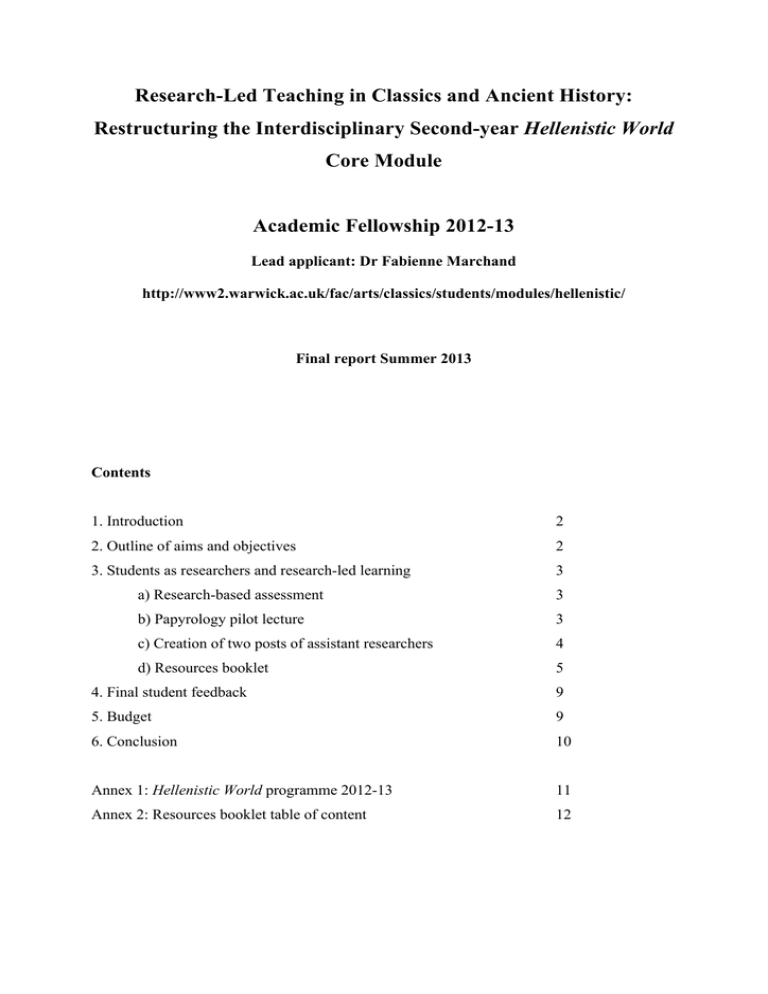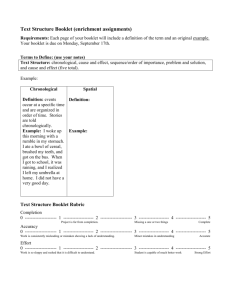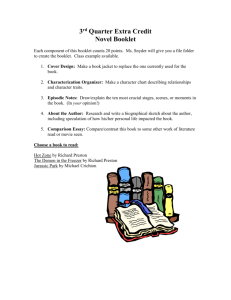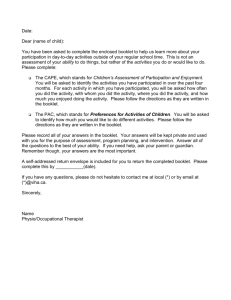Research-Led Teaching in Classics and Ancient History: Hellenistic World Core Module
advertisement

Research-Led Teaching in Classics and Ancient History: Restructuring the Interdisciplinary Second-year Hellenistic World Core Module Academic Fellowship 2012-13 Lead applicant: Dr Fabienne Marchand http://www2.warwick.ac.uk/fac/arts/classics/students/modules/hellenistic/ Final report Summer 2013 Contents 1. Introduction 2 2. Outline of aims and objectives 2 3. Students as researchers and research-led learning 3 a) Research-based assessment 3 b) Papyrology pilot lecture 3 c) Creation of two posts of assistant researchers 4 d) Resources booklet 5 4. Final student feedback 9 5. Budget 9 6. Conclusion 10 Annex 1: Hellenistic World programme 2012-13 11 Annex 2: Resources booklet table of content 12 2 1. Introduction This project aimed to reorganise and restructure the 2nd-year team-taught interdisciplinary core module (Hellenistic World), taken each year by c. 50 students. The module is compulsory for all students enrolled in Classical Civilisation (and its variants), as well as Ancient History and Classical Archaeology. It is optional for our Classics degree. The module is also offered to Erasmus students, and to students from other departments. This is a very distinctive part of the degree courses we offer, and also forms a crucial component in the pathways for progression among our students. Following a recent audit and feedback from students, it appears that in its current configuration the module is perceived to lack coherence and coordination, and that more attention ought to be devoted to the specific needs of second-year students. To an extent the very nature of the period covered – the various kingdoms of the Hellenistic World – and the variety of primary evidence involved – literary, documentary, archaeological – make the period feel disjointed, a feature often highlighted by students in their feedback. Our challenge was to overcome this inherent characteristic of the historical period. 2. Outline of aims and objectives One of the main aims and objectives of this project was to set up in the long term a core module specifically adapted to the needs of 2nd-year students. The legacy of the project is to put into place an innovative and long-term structure for the Hellenistic World core module of the Department. The student-centred aspect of this project aimed to develop the students’ ability to think as historians, notably by increasing their sophistication in dealing with primary materials, from texts to coins, sculpture, and other archaeological material. This project is also an excellent opportunity to develop the students’ ability to act as researchers. 3 3. Students as researchers and research-led learning Research-led learning was develop along four main avenues: a) Research-based assessment This aspect was fully developed in the interim report and will not be repeated here. Overall the outcome is very positive, as most students expressed satisfaction with the new type of summative assessment. b) Papyrology pilot lecture The Department of Classics and Ancient History gathers a pool of highly specialised researchers in various fields of Classics and Ancient History, including numismatics, epigraphy, archaeology, and literature. To complement our offer, Dr Amin Benaissa, Fellow and Tutor in Classics (Lady Margaret Hall, Oxford), was invited to give two pilot introductory lectures in papyrology during week 1 of the Spring Term (see newly developed Hellenistic World programme in Annex 1). As Dr Benaissa specializes both in literary and documentary papyrology, his lecture fit particularly well within the newly restructured programme (see Annex 1), following a sub-section on Literature and Art, and just before students were introduced to aspects of Economy and Society. Feedback from the students indicates that an introduction to papyrology, to complement the Department’s strengths in other primary sources for Ancient History, is more than welcome. Students were pleased to be introduced to a new type of sources. Since our core module is compulsory, sometimes students who wish to specialise in literary topics do not engage well with historical topics, and vice-versa. Lectures on documentary and literary papyri brought satisfaction to students with very diverse interests. The positive feedback from the students this year has let the Department to decide to renew the experience, and in the future the Hellenistic World module will include an introduction to papyrology given by a guest lecturer. 4 c) Creation of two posts of assistant researchers Two undergraduate students who took the Hellenistic module during the 2011-12 academic year were employed to develop during the summer vacation (2012) web pages gathering and criticizing electronic resources for the use of future students taking the module. The page, available exclusively to students enrolled in the module and to academic staff, can be found here: http://www2.warwick.ac.uk/fac/arts/classics/students/modules/hellenistic/weblinks/ These pages aim to encourage a peer-to-peer collaboration, to develop students’ ability to be critical when browsing the web for academic purposes, and to lead students to acquire independence and autonomy. The two students worked hard over the summer break and gathered as many as 32 websites for which they provided critical reviews, and also gave tips on how to use some of the most challenging websites, typically scholarly databases. They arranged the reviewed websites in nine categories, as follows: general (10 sites), Hellenistic kings (2 sites), geographical studies (3), literature and texts (5 sites), museums (2 sites), philosophy (1 site), warfare (1 site), coins (4 sites), and papyrology (4 sites). Feedback gathered at the end of the 1st term revealed that seven students used this page every week, 14 a couple of days during term time. For some unexplained reasons, the use of this webpage decreased over time, as statistics generated Sitebuilder reveal that during the Autumn term the page received 211 visits, while in the second term it was visited only 59 times. Students seem to have returned to the pages while preparing examinations, with 85 visits during the Summer term. The reason for the drop in interest remains unclear, but it may be linked with the fact that the interest for the electronic version of the resources booklet dramatically increased at the same time (see below). This selection of reliable electronic resources made available to students had an impact on the summative assessment and quality of written work. Compared to previous experience in teaching Ancient History at Warwick, I noticed this year fewer references to unreliable websites in students’ essays. Students were also more rigorous in their quoting of electronic sources. Furthermore, several students in their pieces of written work showed that they had 5 performed independent personal research with these electronic resources, for example in coin or art databases. They displayed the ability to ask relevant academic questions, and attempted to answer them with data extracted from these electronic tools. Students also were more inclined to include plates and pictures of primary sources in their essays, and overall the quality of pictures, and the way they were handled, was higher than average. d) Resources booklet The Department benefits from a pool of specialised researchers in various disciplines of Classics (epigraphy, numismatics, archaeology, literature), an ideal environment to foster a research-led learning experience. All fields mentioned above are taught in the Hellenistic World core module. The team-taught second-year core module encapsulates these values and offers a unique opportunity for students to engage with all these disciplines and to benefit from the expertise of specialists in their own fields. The core module not only introduces students to the methodologies specific to each of these fields, but also invites them to think more globally about the Ancient World and about the tools of interpretations used by Historians. To strengthen the link between the various disciplines taught in the Department and in the Hellenistic World module, a 111-page common learning resources booklet was compiled over the summer 2012 by the module leader (see table of content in Annex 2). The booklet was designed to serve throughout the academic year and therefore included very varied material, useful for essay writing, seminars and examinations. The final result is a richly illustrated booklet containing 158 entries consisting of translations of inscriptions, papyri, literary texts, photographs of coins, sculptures, plans of cities, and maps. Fifty copies were ordered from Warwickprint (budgeted), and a pdf was made available online at the following address: http://www2.warwick.ac.uk/fac/arts/classics/students/modules/hellenistic/handouts/ Access was strictly restricted to students enrolled in the module and to members of staff. A hard copy was submitted earlier in the academic year to Dr Catherine Hanley. 6 The aims and objectives of this new resource booklet were as follows: • to enable students to acquire a sense of unity of the module and of the Hellenistic period; • to develop the students’ skills as researchers in each discipline (numismatics, epigraphy, art, etc.; • to foster independent research; • to increase the students’ curiosity for the topic; • to challenge and stimulate the students; • to enable to students to learn new methods and skills; • to foster the students’ responsibility and control of their learning experience in their second year. As specified in the interim report, not all students came to pick up their hard copy, which at first sight was disappointing. A questionnaire administered at the end of the first term revealed that 28 students out of 31 downloaded a copy on their laptop, and many also on their iPad/tablet, and even smartphone. It also appears that the resources booklet was advertised among students via Facebook, and that the booklet was passed on to students enrolled in other modules. Students showed a very clear preference for the electronic format. Statistics generated by Sitebuilder are particularly eloquent: Autumn term 2012 1,134 hits Spring term 2013 2,643 hits Summer term 2013 33,628 hits July-August 2013 3 hits Throughout the academic year Students showed an increased appreciation for the resources booklet, and they seem to have continuously gained confidence in using it. Some students made excellent use of the booklet in their essays and showed that they were able to handle primary sources in a more and more sophisticated manner. The remarkable 33,628 hits in the summer term are to be explained solely by the fact that students heavily used the booklet to 7 prepare themselves for the examinations, as no essays were requested in the summer term. Students reported using the booklet in particular to prepare for gobbets. The three hits during the summer term show that some students might already been thinking about their third (final) year and about a dissertation topic. Perhaps more students will chose for a topic in Hellenistic history than in previous years (to be confirmed). To evaluate the impact of the booklet on the students’ learning experience this year a questionnaire using a 4-point Likert-type scale was administered in May 2013. Students were asked to rate from 4 to 1 (from ‘indispensable’ to ‘completely useless’) the usefulness of the resources booklet for essay writing and for revisions. Results for both questions were almost identical. A vast majority of students rated 3 out 4 the usefulness of the booklet, with no students finding it completely useless. One student explained using the booklet to revise for examinations because it ‘just makes everything available in one place for revision. Would recommend using it again’. The sections elected most popular by the students are inscriptions, art and papyri, showing that students engaged well with papyri thanks to the pilot introductory lecture. Greek and Latin poetry did not rate as well. The main reason behind this is that these are easily available elsewhere, as a student duly noted (‘Poetry can be found elsewhere’). Sections on maps and sites were received with mixed feelings. I noted throughout the year that several students have poor geographical background and was hoping that the booklet would help them acquire relevant knowledge. Feedback seems to indicate that students are not comfortable using maps and plans of sites, and this will need to be addressed in future years. One student even suggested removing these two sections from the booklet. The booklet was designed to meet various needs, from essay writing to seminars and examinations. Therefore the quantity of material made available was significant. Some students felt somewhat intimidated by the amount, and suggested to reduce the number of pages of the booklet (‘A little overwhelming in terms of the number of sources – could this be cut down?’). However, as mentioned above, only one student clearly expressed the wish to see sections removed. All other students do not wish any section to disappear. One student perhaps summed up well the general feeling towards the quantity of material made available: ‘It’s intimidatingly long, but the material itself isn’t a waste of space’. Perhaps in the future it will need to be specified to students that it is not expected of them to show deep knowledge of 8 all entries. Two thirds of students do not want the booklet to receive additional sections in the future. Students who do suggested the following topics: wars and battles, science, trade, economics. One student suggested family trees and lines of succession. A student also suggested a timeline. Although the booklet was designed for independent research, some students expressed the wish to receive additional guidance. Some expected to find in the booklet pre-prepared material for seminars for examples, and others wanted a collection of handouts for the whole academic year, despite the fact that these can be all downloaded one by one on the module website. It transpires therefore that some students expect more ‘spoonfeeding’ from the booklet, for example an analysis of the text presented, or a description of the coin or the sculpture. These were deliberately not included as not to overload the booklet, but references to such analyses were provided when available. Despite the fact that some students wish more guidance, others find that intrinsically the booklet is making their work easier (‘It has been helpful because you don’t have to go trawling through books and websites for a particular source’). Among students who found the booklet very useful, some regretted using it too late in the academic year (‘Would have been very useful if I realized the stuff was in there’; ‘I didn’t actually use it very much, but some of the sources I found independently were in it and I might have done better if I’d used it more’; ‘I’m sure I could have used it more’). As a result, next year I will make sure that students are more thoroughly and systematically introduced to the content of the booklet, and to its aims and objectives. This hopefully will lead them to make the most of the resources available. One student found the booklet particularly useful during the first weeks of the Autumn term to ‘get a “feel” for the material available’, and perhaps next year’s students can be encouraged to do the same. Given the reported popularity of the electronic format, students were asked whether they had used the booklet for other purposes than Hellenistic World essays and examinations. General curiosity has been expressed: ‘I read parts of it because they were intrinsically interesting’, while another student reported using it for ‘general reading out of curiosity’. One student even boasted about using the booklet for ‘entertainment’ – to be taken with the appropriate pinch of salt. Even the smallest amount of interest (‘I read something about Antiochus IV and the Jews 9 (I think)’) is a positive outcome. Some students also reported using the booklet for assessed work in other modules, notably Art and Architecture. The resources booklet is no doubt a very useful tool that will be used again in forthcoming years. Not a single student recommended not to use it in the future, as it is perceived as ‘a good reference point’. From the point of view of the module leader, it seems clear that students gained in confidence with the primary sources, and that summative assessment in particular benefited from the use of the booklet, assessed essays but also examinations. I was positively surprise to notice a difference in examinations: obviously some students had been studying primary sources that had not been discussed with tutors in lectures and seminars. This seems to indicate that some students read new material on their own, and not only understood it, but were also able to link it with previously acquired knowledge in classes. This independent and deep approach to learning is certainly is one of the most positive outcomes of the resources booklet 4. Final student feedback Over the past ten years students have regularly expressed dissatisfaction with the module. For the first time this year the module was rated on average 4 out of 5 at the following questions of the Department feedback questionnaire: • Did the module literatures give you a clear understanding of the objectives and content of the module and the assessment requirements? • Did you find the module interesting? • Did the lecturer present the material clearly and thoroughly? • Was the marking of written work prompt, fair and helpful? Students overall were pleased with the new structure and many expressed satisfaction with the variation of topics throughout the year (‘Good variation of art/literature’). Among general comments, it appears that students want more lectures and more seminars. Several students expressed the wish to be taught more philosophical topics. Next year, instead of one seminar 10 only on Hellenistic philosophy, one lecture will be added to the programme. Several students engaged well with various topics and wish additional time for discussions (‘More time for informal debate & discussion’). 5. Budget All the budgeted money was spent exactly as planned. 6. Conclusion The most positive outcome of this project, as expressed in this report and the interim report, deals with the summative assessment of the module. Besides expressing general satisfaction with the new structure and content of the module, students appeared to be keen to get involved with the module electronically. The two most popular subpages of the Hellenistic World module website are indeed those making lecture handouts and powerpoints available for downloading. Given the remarkable interest expressed by students for the electronic version of the resources booklet, it seems that future developments for the Hellenistic World module could go into the direction of building a VLE. The possibility of using a VLE for the module was evoked in the original proposal for this academic fellowship, but since Moodle is only being adopted very slowly throughout the University we have not been able to implement it (yet). Overall this year the 2nd-year Hellenistic World module has been successful thanks to this IATL academic fellowship, which has generated the expected outcomes. The long-term legacy of this project includes the use of the resources booklet, the introduction of a papyrology lecture and a re-designed programme more adapted to the needs of 2nd-year students. As module leader I wish to thank IATL, and particularly Dr Catherine Hanley, for their support and advice. 11 Annex 1: Hellenistic World programme 2012-13 LECTURES Autumn term Week 1: Introduction Week 2: The early Hellenistic kingdoms Weeks 3-4: Antigonids, Seleucids and Attalids down to the Peace of Apameia Week 5: Ptolemies and Ptolemaic Alexandria Week 6: Reading week. Literature and Art Weeks 7-8: Literature Weeks 9-10: Hellenistic Art Spring Term Economy and Society Week 1: Introduction to Papyrology (guest lecturer: Dr Amin Benaissa, Oxford) Week 2: Economy Week 3: Hellenistic coinage: an introduction Week 4: Religion Week 5: Magic and Science Week 6: Reading week The Coming of Rome Week 7: From Apameia to Actium: the restructuring of the Hellenistic world Week 8: Rome and the Hellenistic World Week 9: Hellenization of Italy Week 10: Reception of Hellenistic poets in Latin poetry Summer Term Week 1: Athens and Delos Weeks 2-4: Revisions 12 SEMINARS Seminar 1: Aspects of Hellenistic kingship I: Plutarch, Life of Demetrius Seminar 2: Aspects of Hellenistic kingship II: Hellenistic kings and their subjects Seminar 3: Aspects of Hellenistic kingship III: portrait of a Hellenistic King Seminar 4: Stoics and Epicureans Seminars 5 and 6: Hellenistic cities Seminar 7: Life in Hellenistic cities Seminar 8: SC de Bacchanalibus Annex 2: table of content of Resources booklet 9 sections, 158 documents xxxxx images A. Inscriptions (nos. 1-39) 1 B. Papyri (nos. 40-47) 31 C. Texts (nos. 48-56) 37 D. Greek poetry (nos. 57-68) 43 E. Latin poetry (no. 69-70) 59 F. Coins (nos. 71-84) 63 G. Art (nos. 85-121) 69 H. Sites (nos. 122-150) 85 I. Maps (nos. 151-158) 99 Abbreviations 107


